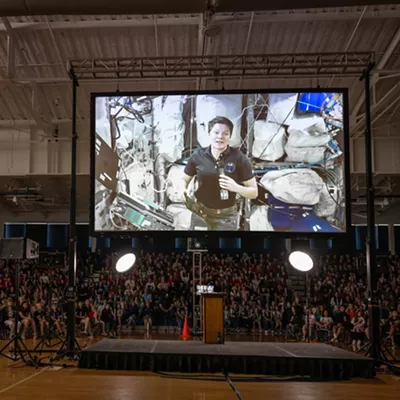
Ceila is a fourth-grader at Roosevelt Elementary — at least for now. Just a few months ago, she was a student at Broadway Elementary. Like many of her peers, Ceila’s had to manage school while bouncing from place to place.
“I’ve went from my house, to my grandma’s house, to an apartment, to my other grandma’s house, then to my uncle’s house, and pretty soon I’ll be moving to my apartment next month,” Ceila says. In the last two years, says her mother, Katherine Lee, they’ve moved eight times.
It’s a common situation, as teachers at Roosevelt know.
Last year Roosevelt had more mid-year turnover — a higher “mobility rate” — than any other public school in Spokane.
The South Hill school of about 400 students saw 28 withdrawals and 116 enrollments after the start of the school year. Some of those may have been the same students — leaving in October and reappearing in April.
The Spokane Public Schools district has tried to alleviate the problem by making curriculum consistent throughout the district and by ensuring homeless kids can remain at one school. But it’s mostly fallen to individual schools and teachers to figure out how to teach students constantly in transition.
“If they’re moving in April, they’ve missed 80 percent of our curriculum,” says a Roosevelt sixth-grade teacher, Tina Carson.
“We serve the city core — that’s unique to us,” Roosevelt Principal Matthew Henshaw says. While Roosevelt’s boundaries stretch up to the lower South Hill, it also serves homeless shelters like St. Margaret’s, drug rehab facilities like the Isabella House, and the Ronald McDonald House, where sick children temporarily stay with their families. World Relief places refugee families in a nearby apartment complex.
The result: Some Roosevelt students are perpetually in transition.
Poverty exacerbates the problem. Schools in the parts of Spokane with higher poverty rates — West Central, East Central and Hillyard — have some of the highest mobility rates. The lowest rates are in far-flung wealthy suburbs like Moran Prairie, on the upper South Hill, and Woodridge, in the northwest.
Brenda Van Matre laughs when asked about student mobility. She is a first-grade teacher who’s been at West Central’s Holmes Elementary for 28 years. “Today, I just got my fifth new student in a month and a half,” she says.
As an experienced teacher, she knows the toll that moving to a new school has on students.
“Of the five new children who’ve entered my room, one is at grade level,” she says. “The other four are significantly below grade level.”
One national study shows that, if a student changes schools enough times, it can set them back an entire year. Roosevelt’s statistics support that assertion. At Roosevelt, the passing rate for students taking standardized math tests in grades three through five improves by about 3.5 percentage points when late-entry students are removed from the equation.
Sixth-grader Savannah, a Roosevelt student wearing an AC/DC shirt, knows the academic challenge that comes with school-switching. As her mom has been searching for jobs, Savannah’s had to transfer between three different schools. Most recently, she left Grant Elementary.
Suddenly, she wasn’t learning about planets in her science class anymore. As soon as she transferred, she says, she was in the midst of decimal multiplication in math class — something she hadn’t yet learned at Grant.
Spokane Public Schools has tried to fix that problem. “We have a managed curriculum,” says Tammy Campbell, director of teaching and learning services. For about seven years, teachers have had set deadlines to complete specific units. Ideally, if a student in the middle of learning about fractions transfers from Holmes Elementary to Roosevelt, they’ll still be learning about fractions. But there’s still flexibility within a unit, so that’s not a perfect solution.
Talk to students who’ve moved a lot — and they don’t complain about the academics first. They complain about their social life.
“It’s kind of like, you don’t get to see your friends,” Savannah says. “You have to leave them.” She was relieved when her mom didn’t get the job she’d applied for in Seattle. One of her classmates recently had to move to Seattle, she says, and now he’s suddenly a sixth-grader in middle school, being bullied by eighth-graders.
“We try to help them acclimate as quickly as possible,” Melissa Alfstad, a counselor at Roosevelt, says.
Roosevelt developed the “New Kid on the Block” program. On the first day, each new student is taken on a tour, introducing them to teachers and staff. They’re given a pamphlet to gather teachers’ signatures, after following instructions like “Go to the lunch room and meet Ms. Ellie. Introduce yourself, get her autograph and tell her your favorite school lunch!”
Alfstad may ask older students to help younger, newer students. She sometimes asks students which kids they’d like to hang out with — and then sets them up in a lunch group.
Yet, many kids have deeper problems. The catalysts for switching schools — sometimes divorce, homelessness, abuse, poverty, even the experience of fleeing refugee camps — still loom.
Ceila’s mom speaks openly about the reason they’ve bounced around so often.
“I have bipolar disorder. I don’t do well with others,” Katherine Lee says. She notes that the lack of stability recently has made it hard for Ceila to be a kid. “Since we’ve become homeless, we’ve seen a lot of fly-off-the-bat behavior. She doesn’t know what to expect.”
Yet, Roosevelt has helped Ceila with those issues as well.
“Mrs. Alfstad has really helped me out,” Ceila says. “I talk to her, like when I was having trouble when my mom relapses.”
In Nevada, a state with an extremely mobile student population, groups like Communities In Schools are fighting the issue at its roots, by channeling resources to allow families to stay put, helping them with things like utility bills.
Ceila’s mom says that she, too, had to move schools a lot when she was a kid. That’s part of the reason she dropped out in ninth grade and became pregnant.
She doesn’t want that for her daughter. So now, no matter where she has to move, she says, she’ll keep her daughter at Roosevelt. Parents without a fixed location can use the district’s Homeless Education and Resource Team program to keep their children in the same school.
“Things are starting to get better,” Katherine Lee says. “We just signed a lease yesterday.”

























